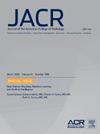Impact of Deep Learning-Based Computer-Aided Detection and Electronic Notification System for Pneumothorax on Time to Treatment: Clinical Implementation
IF 4
3区 医学
Q1 RADIOLOGY, NUCLEAR MEDICINE & MEDICAL IMAGING
引用次数: 0
Abstract
Objective
To assess whether the implementation of deep learning (DL) computer-aided detection (CAD) that screens for suspected pneumothorax (PTX) on chest radiography (CXR) combined with an electronic notification system (ENS) that simultaneously alerts both the radiologist and the referring clinician would affect time to treatment (TTT) in a real-world clinical practice.
Methods
In May 2022, a commercial DL-based CAD and ENS was introduced for all CXRs at an 818-bed general hospital, with 33 attending doctors and their residents using ENS, while 155 others used only CAD. We used difference-in-differences estimates to compare TTT between the CAD and ENS group and the CAD-only group for the period from January 2018 to April 2022 and from May 2022 to April 2023.
Results
A total of 603,028 CXRs from 140,841 unique patients were included, with a PTX prevalence of 2.0%. There was a significant reduction in TTT for supplemental oxygen therapy for the CAD and ENS group compared with the CAD-only group in the postimplementation period (−143.8 min; 95% confidence interval [CI], −277.8 to −9.9; P = .035). However, there was no significant difference in TTT for other treatments, including aspiration or tube thoracostomy (14.4 min; 95% CI, −35.0 to 63.9) and consultation with the thoracic and cardiovascular surgery department (86.3 min; 95% CI, −175.1 to 347.6).
Conclusion
The introduction of a DL-based CAD and ENS reduced the time to initiate oxygen supplementation for patients with PTX.
基于深度学习的气胸计算机辅助检测和电子通知系统对治疗时间的影响:临床实施。
目的评估在真实世界的临床实践中,实施深度学习(DL)计算机辅助检测(CAD)来筛查胸片上的疑似气胸(PTX),并结合电子通知系统(ENS)来同时提醒放射科医生和转诊临床医生,是否会影响治疗时间(TTT):2022 年 5 月,一家拥有 818 张病床的综合医院引入了基于深度学习的商用 CAD 和 ENS(DL-CAD-ES),33 名主治医生及其住院医生使用 ENS,其他 155 人仅使用 CAD。我们使用差异估计值比较了2018年1月至2022年4月和2022年5月至2023年4月期间CAD和ENS组与仅使用CAD组的TTT:共纳入 140,841 名患者的 603,028 份 CXR,PTX 患病率为 2.0%。与单纯 CAD 组相比,CAD 和 ENS 组在实施后补充氧气治疗的 TTT 明显减少(-143.8 分钟;95% 置信区间 [CI],-277.8 至 -9.9;P = .035)。然而,其他治疗的 TTT 没有明显差异,包括抽吸或胸腔插管造口术(14.4 分钟;95% CI,-35.0 至 63.9)以及胸外科和心血管外科会诊(86.3 分钟;95% CI,-175.1 至 347.6):结论:采用 DL-CAD-ENS 缩短了 PTX 患者开始补氧的时间。
本文章由计算机程序翻译,如有差异,请以英文原文为准。
求助全文
约1分钟内获得全文
求助全文
来源期刊

Journal of the American College of Radiology
RADIOLOGY, NUCLEAR MEDICINE & MEDICAL IMAGING-
CiteScore
6.30
自引率
8.90%
发文量
312
审稿时长
34 days
期刊介绍:
The official journal of the American College of Radiology, JACR informs its readers of timely, pertinent, and important topics affecting the practice of diagnostic radiologists, interventional radiologists, medical physicists, and radiation oncologists. In so doing, JACR improves their practices and helps optimize their role in the health care system. By providing a forum for informative, well-written articles on health policy, clinical practice, practice management, data science, and education, JACR engages readers in a dialogue that ultimately benefits patient care.
 求助内容:
求助内容: 应助结果提醒方式:
应助结果提醒方式:


